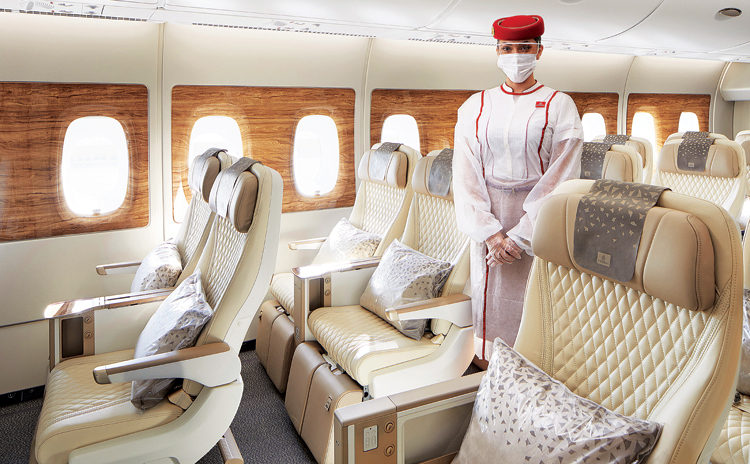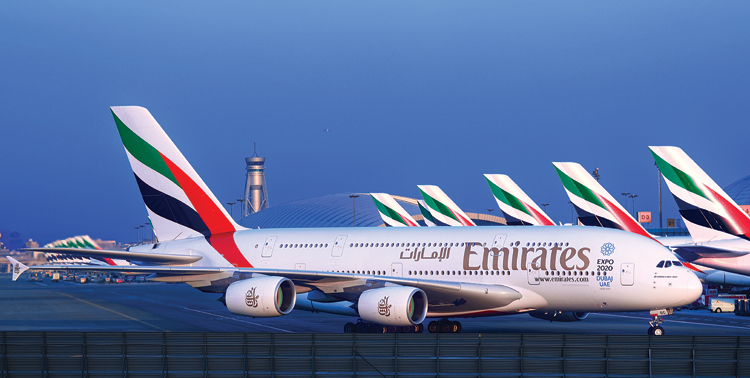Middle East Aviation - Adapting to a Changing Landscape
The migration to fleets of more fuel-efficient and versatile aircraft is underway with Emirates moving to a simplified fleet of smaller airplanes, Qatar Airways embracing the smaller-jet philosophy and Etihad Airways positioning itself as a mid-size carrier

The Middle East has always been at the crossroads of global trade. Today’s airline mega-hubs at Dubai, Doha, Abu Dhabi and even Istanbul are testament to the region’s ability to adapt to changes in the flow of world commerce.
Those hubs are uniquely positioned to capture both north-south and east-west movements of cargo and people, and thrive on vast non-stop regional and intercontinental flight connections. Yet those very links that are their lifeblood are at risk with the contraction of passenger traffic resulting from the pandemic. Can airlines in the Middle East withstand the downturn and emerge stronger when demand eventually recovers? With a little help from government handouts, it appears they are already adapting to the new landscape.
A REGION HIT HARD
Secretary General Abdul Wahab Teffaha painted a grim picture in his remarks to delegates at the Arab Air Carriers’ Association annual general meeting in Doha. He cited an 80 per cent decline in passenger traffic (RPKs) among member carriers in the first half of 2021 compared to the same period in 2019. Demand has still not shown signs of recovery given that traffic was down 72 per cent in the first half of last year.
The pandemic has hit the region hard. AACO blames disparate international health regulations, the inequality in access to vaccines, and a reliance on open borders as causes for depressed demand. The cost of continued uncertainty is high. Prior to the onset of the pandemic, tourism accounted for 14.4 per cent of GDP in the region. That contribution dropped to 5.4 per cent, as did the number of tourism-related jobs, from 334 million in 2020 to 272 million in 2021.

One bright spot is the success of LCCs, namely Air Arabia. The airline reported a $152 million profit for the quarter ending September 30, a 575 per cent jump compared to the same period in 2020.
Abdul Wahab Teffaha believes demand could return to 2019 levels by 2024 if travel restrictions are lifted, economies recover, and governments support member carriers. If delays continue or there are new outbreaks that reimpose border closures, the date could be pushed out to 2027.
CONFIDENCE IN THE GULF
The region’s biggest airline is rebuilding its network and reactivating its parked fleet although the carrier is still operating below 2019 levels. Sir Tim Clark, Emirates Airline President, remains optimistic. At the 2021 Dubai Airshow, he noted that the easing of travel restrictions was met with a surge in new bookings. He believes that immediate rebound is an indication of tremendous pent-up demand.
Emirates is so confident the strengthening traffic trend will continue, that it intends to have 50 A380s back in service by the end of 2021 and the entire airline network restored by the middle of 2022. All 145 of the carrier’s B777-300s are back in service.
Despite continuing losses, Qatar Airways aggressively relaunched services in 2020 after grounding aircraft, including all 10 A380s, at the beginning of the pandemic. It subsequently reduced capacity only to add it back again this year and should be flying about 75 per cent of its 2019 seats by the end of 2021, according to CAPA.
Qatar Airways CEO Akbar Al Bakar is refining the airline’s fleet strategy for a post-pandemic environment. Although a handful of A380s have returned to short-term service, Qatar is acquiring more smaller-capacity widebodies that will allow it to expand aggressively in Europe. The new European Union – Qatar liberalised air transport agreement grants unlimited reciprocal nonstop market access between Doha and cities in Europe. The arrangement will give Qatar a huge market share advantage over European carriers who will find it difficult to connect their passengers at a competitor’s hub.
BIG IS OUT. SMALL IS IN
Middle East carriers had recognised that mega-jumbos were falling out of favour both economically and environmentally before the pandemic began. Emirates, Qatar, and Etihad had all capped orders for the A380 before the programme was cancelled. The migration to fleets of more fuel-efficient and versatile A350s and B787s is underway.

Emirates has 50 A350-900s and 80 B787-9s on order, a reflection of its move to a simplified fleet of smaller airplanes. It also reduced its initial order for 150 B777-X twin-jets to 115 and hopes to see the first deliveries at the end of 2023.
Qatar Airways in embracing the smaller-jet philosophy so that it can nimbly serve new destinations as a consequence of the recently-signed accord with the European Union. The timing of the delivery of 23 more B787-9s, 23 more A350-1000s, 50 A321neos and 60 new B777Xs could be fortuitous when demand returns.
Etihad Airways, plagued by staggering losses, changed its strategy and is positioning itself as a mid-size carrier, according to Etihad Aviation Group CEO Tony Douglas. In an interview with CAPA earlier this year, Douglas attributed maintaining the carrier’s network and frequencies during the worst of the pandemic to the strength of its cargo business and Etihad’s newfound agility.
Now that its A380s are unlikely to return to service and the B777-300ERs will leave the fleet by the end of 2021, the airline will focus on the A350 and B787, although it still has orders for 25 B777Xs on the books.
ASIA IS CRITICAL
Consensus among airline leaders and analysts is that global traffic will recover to 2019 levels around 2024. The prediction is, of course, unpredictable. Sudden outbreaks of new, vaccine-resistant covid variants can quickly shut international borders, rattle traveler confidence, and throw airline schedules into a tailspin.
Carriers in the Middle East rely on the steady flow of north-south and east-west passengers to fill their aircraft cabins and cargo holds. While Europe and North America have been quick to re-establish links, Asia and the Pacific - the source of much of east-west commerce - remain essentially closed. The region is crucial to Middle East trade yet access to the huge tourist and business markets of Taiwan, China, Japan, Hong Kong, and Australia are stubbornly slow to re-open.
Countries have tried innovative approaches – Sandbox tourism in Thailand and Vaccinated Travel Lanes (VTL) in Singapore with limited yet promising results. Even with controlled entry, the number of flights between Asian countries remains a fraction of 2019 frequencies.
Singapore opened VTLs with Qatar, Saudi Arabia and the UAE in December for a total of 21 channels. The country has ongoing talks with Turkey to establish a VTL. India was added to the VTL list in November.
MASTERS AT ADAPTING
Re-opening international borders with Asia is critical to a speedy recovery for Middle East carriers. Governments have the authority to decide when and how they will re-establish connections with countries they deem low risk. The timing is critical yet complicated and depends on vaccination rates, emerging variants, economic stability, and the evolution of covid from pandemic to endemic.
Despite the uncertainty, Middle East carriers are already positioning themselves for the new post-covid environment. Smaller capacity, new-generation, more efficient aircraft will ensure they emerge strong and competitive, as always.





